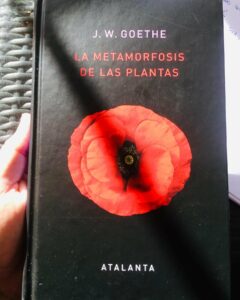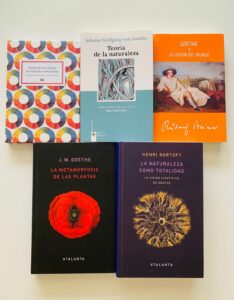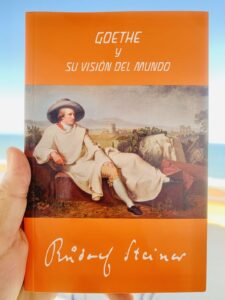In 2022, the Atalanta publishing house published in Spain the precious and delicate work of Professor Gordon I. Miller, from Seattle University, who has republished “The Metamorphosis of Plants”, a work by the German philosopher and writer Goethe (with wonderful illustrations and photographs, by the way).
In this post I come to share with you some fragments, essentially from the introduction and epilogue, about what I found most interesting and applicable to our work in the vineyard: the way in which we observe the vegetal world, and what makes up one of the basic pillars of biodynamic agriculture and the general vision of Rudolph Steiner.
Steiner translated much of Goethe’s scientific work and was his main inspiration throughout his life. These were the beginnings of modern science and perhaps the moment where the paths diverged, on the one hand mechanistic materialist science led by Newton, and on the other hand those who tried not to separate science from poetry, matter from spirit. The science that triumphed was mechanistic, and it has allowed society great advances. However, these advances have in many cases been costly on an environmental and human level.
In our now, and thanks to that science, perhaps we are in a position where we can attend to other sensitivities that bind us to nature, instead of fighting against it.
GOETHE AND STEINER
Steiner’s reference was Goethe, Johann Wolfgang von Goethe.
Goethe glimpsed the existence of a deeper dimension in plant life, beyond what can empirically be seen, touched, smelled or classified, which consolidates and guides the formation and transformation of plants.
For him, poetry and science should go hand in hand, just as “spirit and matter, soul and body, thought and extension (…) are the pairs of basic ingredients of the universe and will continue to be so forever”; and he wondered why “people have forgotten that science has developed through poetry and were wrong not to contemplate that a swing of the pendulum could unite them and remove them to a higher level for mutual benefit.”
To the prevailing currents of science he asked the following: “Can a mechanistic and materialist approach, focused on innumerable individual surface structures, meet the challenge of explaining the living organism or the life of nature as a whole?”
Goethe proposed a union, not a division; a connection with a “delicate empiricism that is formed identical with the object.”
This holistic and integrative vision was inspired by Baruch Spinoza who defended that spirit and matter are the pairs of basic ingredients of the universe and will always continue to be so. And for this reason, the observer must use “both the eyes of the body and the eyes of the mind, both sensory and intuitive perception, in constant and spiritual harmony”. This form of knowledge was ultimately based on a harmony and identity between the human spirit and the informing spirit of nature, in which “one spirit speaks to the other.” And for this, Goethe proposed a method of understanding, which he called the genetic method, -not in relation to genes-, but related to the genes of plants. In line with Spinoza, he postulated that nature could be conceived in two ways: as creative power and as created power. This same approach was already presented by Spinoza, who differentiated between natura naturas (creative nature) and natura naturata (created nature).
And he worked to complete empiricism with imagination in order to see nature completed and unified as a creator and as a creator.
The first part of the method consisted of observing the formative stages of the plant or an element of it, such as the leaf, seeing the differences in each step. The second part of the method requires what Goethe called “exact sensory imagination,” which consisted of imagining common laws of said training process. But Goethe went a little further. In this imagination he defended “knowledge from the inside”, breaking the duality of a “curious subject who knows a strange object” and proposing knowledge thanks to the participation or even the identification of observer and observed. As he said, “our spirit comes into harmony with those simplest powers that underlie nature and is able to represent it to it with as much purity as the objects of the visible world are formed in a clear eye.”
Goethe called the two cognitive faculties involved in this effort: “understanding” to rational thought (which constitutes the common instrument of conventional science: and “reason” to the intuitive perception that feeds poetic sensitivity. That sensitivity, “when it aspires to touch The divine must deal only with what becomes and is alive; the (rational) understanding, on the contrary, deals with what has already become and fossilized, in order to be able to take advantage of it.
“Thanks to an intuitive perception of the eternal creative nature we can become worthy of spiritually participating in its creative processes.” Somehow “Goethe was aware that perceiving the essence of metamorphosis implied a beneficial metamorphosis in the essence of the person who perceived it” concludes Professor Miller in his fantastic book.
Another step was taken by Steiner, by not only observing and understanding, but also finding guidelines to intervene in plants through his biodynamic agriculture.








